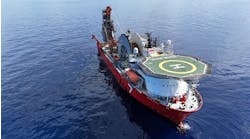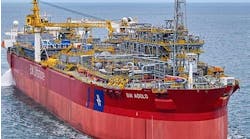The oil industry's experience base in deepwater well control is limited. To date, there have not been a significant number of events upon which to build. The number of wells drilled in water depths greater than 1,500 ft is very small compared to the total number of wells drilled offshore. A recent subsea blowout in a vertical exploration well drilled offshore Italy, has presented the industry with the challenge of a dry gas blowout at the wellhead connector.
The well, in 1,985 ft water depth, contained two geologic objectives. The primary geologic objective was a Tertiary-age carbonate package exhibiting primary porosity, and the secondary objective was a Cretaceous-age secondary porosity system. The top reservoir was relatively shallow, and expected at 3,281 ft RKB (1,247 ft below mudline). This reservoir was eventually penetrated on prognosis, with the 9 5/8 in. casing set at 3,271 ft, 10 ft above the reservoir. Drilling continued through the reservoir section in 8 1/2 in. hole.
Initial well kick
Lost circulation was encountered at 3,458 ft, resulting in a well kick. The well was shut in at the subsea blow out preventer (BOP). Attempts were made to stop lost circulation and kill the well by pumping lost circulation material (LCM) and cross-linked polymer pills. All of the attempts to stop the losses with non-reservoir damaging materials were unsuccessful, resulting in the wellbore partially evacuated to gas.
The first indication that the well was not contained within the wellbore was when gas bubbles were observed at the sea surface BOP control pod lines. A remotely operated vehicle (ROV) was immediately launched to examine the riser and BOP. The ROV observed large amounts of gas in the sea around the riser, and could not maintain station due to the rising gas. Maximum depth of of the ROV at this point was 1,804 ft. At this point, it could only be assumed that the well had broached, in spite of the fact that pressure profiles demonstrated this was not possible unless both the 9 5/8-in. and 13 3/8-in. cement jobs were severely compromised. Both cement jobs had been performed without difficulty, and giving no reason to doubt their integrity.
All available cement was pumped down the drill string and the gas flow stopped for approximately 15 minutes, after which the flow resumed. During this period, a brief inspection of the seabed concluded no cratering was at that time present. The flow was monitored by the ROV some distance off bottom while more cement and mud bulk materials were transported to the rig. After a period of time, the gas flow reduced sufficiently to allow the ROV to maintain station close to the seabed and a more thorough inspection was carried out.
The ROV observed that the flow was emanating from the BOP/wellhead connector and not the seabed. The flow was entirely gas with no pollution to the sea. On closer observation, it was established that the wellhead connector was in fact unlatched and the BOP stack lifted from its wellhead seat.
Attempts were made to re-latch the BOP by functioning the connector and re-positioning the rig. This proved to be unsuccessful. While re-positioning the rig, the stack was observed dropping back onto the wellhead and reducing flow, but not stopping it. Several attempts were then made to set cement plugs in this dynamic well situation without success.
Root cause analysis
Subsequent investigation established that the connector had unlatched due to a pressure build-up within the connector. This pressure build-up was caused by a leak across the pistons from the locked, to the unlocked side, and could not vent through the remote ROV intervention system.
A back-pressure dart had been dropped in the drill string and landed in a dart sub in the bottom hole assembly (BHA), prior to the blowout, in order to facilitate stripping. The forward program for the well kill was to set cement plugs through open ended drill pipe (OEDP).
Attempts to recover the dart were unsuccessful and further attempts at pumping LCM pills through the string resulted in the drill string becoming plugged at the dart sub. At this point, stripping the BHA out of the hole was considered unsafe due to the risk of taking large quantities of gas into the riser. As a result, to gain access to the wellbore, the drill string was hung off, sheared, and allowed to drop in the hole.
A mechanical shut-off procedure was chosen as the most expedient method to control the well. This is normally done on surface blowouts by "capping", which is simply installing a BOP stack on the well. This was not an option, as the condition of the wellhead was not known and the success of removing the subsea BOP and "capping" the well may not have completely shut off the blowout. It was the operator's view (following a study of the flow rate/plume effect) that the BOP could not be safely removed. The BOP was acting as a choke and its removal would have resulted in a greatly increased gas flow rate. This would result in a serious hazard to the rig due to the probability of very high surface currents caused by the plume, as well as a greatly increased fire risk.
Current circumstances required that the "shut-off" of the flow be downhole in the wellbore itself, just below the wellhead. The "shut-off" was considered to be a temporary solution to the problem, and once the blowout was stopped, the BOP system would be pulled, repaired, and re-installed on the wellhead. The well would then be permanently abandoned and re-drilled. A deep-set packer was investigated as a permanent abandonment option at this stage of the operation; however, it was concluded to have a lower probability of success in a flowing well.
Packer versus plug
Several different packers and plugs were investigated as solutions for the problem. Selection was complicated by the fact that they are normally run in static wells. The dynamics of a flowing blowout induces extraordinary forces on a packer. The tight clearances between packer rubbers and the casing wall cause a "choking" effect on flowing wells, which in turn creates back-pressure on the well, and results in upward forces on the drill string. Also, the dynamic of a flowing well can cause rapid deterioration of packer elements.
Fortunately, in a subsea operation with the BOP at the seafloor, the riser acts as a "lubricator" in which drill collars can be run to overcome wellbore pressure. The effect of the flowing well can be reduced considerably by a partial dynamic kill. This allowed the packer to be stripped in the hole where a snubbing unit would have normally been required for a well with a surface BOP.
The first flow control attempt used a mechanically set retrievable bridge plug, requiring three downhole string rotations to set properly. A partial dynamic kill, using mud, was performed to reduce the flow. The plug was "stripped" in the hole and set approximately 75 ft below the mudline, stopping well flow. After releasing the plug, the well was observed to be static for 30 minutes. The bridge plug running tool was then pulled into the BOP stack. At this point, the bridge plug unexpectedly released and the blowout resumed. Gas from the well entered the riser and was discharged through the rig's diverter system.
The diverter lines were inadequately sized for the volume of flow encountered, and failed at a 90° turn. The diverter surface rigging was immediately modified to larger diameter piping and a water spray deluge system to safely handle any future diverting that might be required.
A number of factors contributed to the bridge plug failure. The tight annular clearance between the bridge plug gauge ring, packer rubber, and the internal diameter of the casing wall, and the uncertainty in mechanically setting the tool through the closed subsea annular BOP were thought to have been major factors in preventing proper plug setting. Also, the button type slips used on the plug were probably not suited for unsupported casing.
Cement retainer solution
In spite of the plug failure, a mechanical shut-off with a packer was still believed to be the best solution to the problem. Engineers in the operator's office researched various other packers and proposed a hydraulically-set cement retainer as the best candidate. This retainer tool offered several advantages:
- The tool had a smaller outside diameter than the retrievable bridge plug.
- The tool could be set hydraulically and therefore no rotation through the closed annular BOP would be required.
- The slips were much more suitable for setting in unsupported casing.
- The pressure in the well, below the retainer, could be determined before drilling it out if desired.
- The pack-offs on the retainer were packer-type rubbers as opposed to cup-type rubbers found on many retrievable bridge plugs.
- Multiple retainers could be set at closer intervals than was recommended for retrievable bridge plugs.
The obvious disadvantage of the retainer was that it would need to be drilled out, as opposed to being retrieved with a pulling tool. The operational details of running the tool were worked out with the operator, contractor, and well control personnel at the rig. The manufacturer's experts were consulted regarding the use of the tool in this situation. Their recommendations and concerns were fully explored and incorporated into the procedure. The necessary equipment and personnel were sourced and dispatched to the rig.
Prior to running the plug, a slight modification was made in order to isolate flowing wellbore pressure from the internal diameter of the packer elements, preventing element lifting due to gas flow. Following a partial dynamic well kill, using mud, the cement retainer was "stripped" in the hole through the closed subsea annular BOP. The tool was set hydraulically at approximately 69 ft below the mudline. The flow from the well stopped. To complete the operation, a second cement retainer was set 39 ft below the mudline, and a retrievable bridge plug set 36 ft below the mudline. The completion of this procedure rendered the well secure. Critical procedural issues and solutions dealt with in the kill operation included:
- Site safety management at the rig during operations was a concern. The rig team had numerous safety issues to confront and deal with throughout the job to ensure the safety of all personnel at the rig.
- There were concerns regarding the hydraulic controls of several functions of the BOP stack throughout the intervention.
- Diagnostic work was performed to fully identify the flowing characteristics of the well.
- There were numerous problems in planning and designing a relief well should it become necessary. These obstacles were identified and documented early in the process.
- Procedural details for shearing the drill pipe were developed.
- Operational details required to run bridge plugs and cement retainers in a flowing well. The dynamics of the well and the procedures required to strip the tools in the well were complex. Considerable engineering effort went into the procedure required for a partial dynamic kill and selection of fluids to be used.
- Field modifications were made to the cement retainer.
- The diverter system was modified after failure, so that a high rate gas flow would not cause another failure. The initial modifications were temporary for the immediate intervention. Permanent modifications were made while the subsea BOP stack was being repaired.
- A deluge system was set up on the surface equipment at the rig.
Abandonment and re-drill
The cement retainers were set in the first full casing joint below the wellhead. There was no cement behind the casing at this setting depth. The operator deemed this as unacceptable for permanent abandonment of the well. Plans were made to remove the bridge plug and cement retainers and set new plugs in the well at a depth below the top of cement behind the 9 5/8-in. casing, once primary well control had been restored.
The subsea BOP stack was pulled, repaired, and tested. The wellhead was inspected by the ROV while this work was being completed. The wellhead was fortunately undamaged by the event and the BOP stack re-run, latched, and successfully tested.
The retrievable bridge plug was pulled and the cement retainers drilled out, using a closed system with mud motor, water as a circulating fluid, and fluid-returns up the choke and kill lines. Well control personnel were present at the rig during these operations.
After cleaning out the well to the top of the sheared heavyweight drill pipe, a cement retainer was run and set on top of the "fish". A lightweight cement slurry plug was pumped through the retainer to kill the well and serve as the first abandonment cement plug. A conventional well abandonment was then performed.
Experience gained
Deepwater blowouts can happen and can be successfully controlled. An organized team is important to the success of an intervention. A well control representative on the team is beneficial to the other team members. The use of BOP specialists is beneficial in the diagnostic phase and throughout the intervention. The coordinated effort of all of the team members both in the local office and at the rig is vital to a timely solution to the problem. Other valuable experience gained includes the following:
- A mechanical "shut-off" for a subsea blowout is possible in certain circumstances. The water depth allowed running a large number of drill collars, allowing the conduct of stripping operations where snubbing would be required normally.
- An ROV is vital. Monitoring of the flow from the connector was, in this case, critical during all stages of the operation.
- Hydrate formation in a deepwater blowout is not automatic. In this case, there was no problem with hydrate formation, in spite of using fresh water mud during the intervention.
Deepwater well control events will continue to happen. The challenges of dealing with these events are numerous, but can be addressed and overcome in a timely manner if handled by an organized team.


